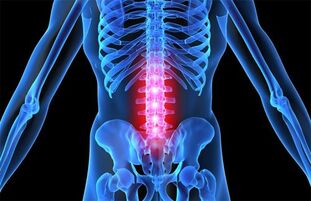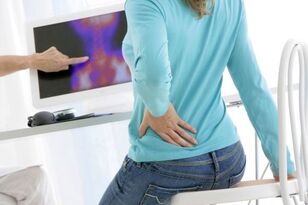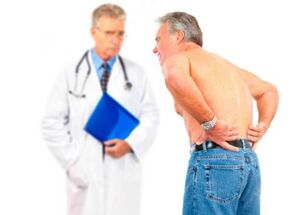A significant mass of a person falls on the lower back and when lifting the load, twisting, from a long static position, it creates additional stress. Excessive stress, improper lifestyle constantly leads to degradation of the musculoskeletal system: the vertebrae and the discs between them, which function as shock absorbers. From now on, it is worth looking for information about osteochondrosis of the lumbar spine: symptoms and treatment. Why is there degradation of the joints of the spine?

The breakdown of the musculoskeletal system occurs as follows: the natural shock absorber of the spine loses its elasticity, shrinks, spreads beyond its natural limits, further increases the pressure from other vertebrae, organs, ligaments. Let's describe those who are prone to acquiring such pathology. Osteochondrosis of the lumbar spine can be observed in people:
- Whose early generations suffered from such suffering;
- Presence of hormonal disorders;
- Individual predisposition to the development of such diseases (eg congenital structure of the spine);
- Those who neglect proper nutrition. At the table every day a person should receive a balanced diet with healthy fats, vitamins, proteins;
- Those who have a sedentary job: sit for a long time or stay in one place for a long time;
- Experiencing a sharp and heavy load on the spine, for example: weightlifters, loaders, people during gardening;
- In diseases of digestion, metabolism, pelvic organs;
- Those who have suffered trauma (pulled their back too hard, hit aside, fall, bend down);
- have reached the age of 30;
- Diabetes.
If there are signs of lumbar osteochondrosis, which are described in the section below, then you should avoid some habits:
- sloppy;
- smoke;
- take a bent posture for a long time;
- moves a little;
- drink alcohol;
- to sit without taking breaks from work;
- dress not for the weather, let the body cool down.
Important. All relationship disorders are exacerbated by being overweight. With overweight, the load on the lower part of the body increases, and the lumbar area, overgrown with fat, is massaged strongly.
Stages of the disease, its signs

Initially, there are intermittent mild pain that intensifies with exercise. This discomfort suggests that it is time to pay attention to osteochondrosis of the lumbar spine. Currently, the intervertebral discs (the disc of the spine is the channel through which the spinal cord and the fibrous ring around it) break down. In addition, the distance between the vertebrae is reduced, the nerves are pinched. The pain becomes severe, covering not only the back but also the thighs, buttocks. In the third stage, the fibrous rings are destroyed, which leads to the formation of a hernia of the spine, irreversible bending and constant pain. The fourth stage leads to damage. The special classification of osteochondrosis of the lumbar spine includes:
- pain;
- ischemic syndrome;
- radicular syndrome;
- vertebral syndrome;
- ossification of overgrown tissues.
Pain sensations have different degrees and nature of severity: lumbago, for example, is called lumbago; persistent, aggravated by stress, lumbodynia; The spread to the lower parts of the body is called lumboischialgia. In cases where diseases of the back are not considered, the vertebrae acquire too much free movement in the spine. There is compression of the nerve roots when lifting loads and sharp actions, then the pain from the lower back disappears, but moves to other parts of the body for which the nerve is responsible. We unconsciously change the position, adjusting so that there is less back pain, but this inevitably changes the gait and curvature of the spine. All this refers to the radicular syndrome, which begins as an irritation and then becomes inflammatory. Signs of osteochondrosis of the lumbar spine with radicular syndrome:
- The back muscles are too tired;
- change back bend;
- gait changes;
- swelling of the lower limbs;
- pain in one or both legs;
- severe pain;
- temporary loss of leg sensitivity;
- intermittent long constipation;
- men have problems with excitability;
- menstrual disorders in women;
- intoxication of the body;
- blood stagnation.
You may notice that painful sensations occur during breaks and when you do back exercises, they subside. Already at this stage it is worth seeking a doctor: chiropractor, surgeon, neurologist, traumatologist (as the causes of osteochondrosis of the lumbar spine include trauma). If you let the disease develop, the problem will increase, supplemented by various satellites:
- heat;
- tingling;
- sweating;
- tingling;
- chills;
- goosebumps;
- impotence;
- intestinal colic.
The muscles of the back lose their tone and this leads to a general loss of motor functions of the person. In the case of a particularly dangerous course of the radicular syndrome, paralysis will occur. Ischemic syndrome is associated with radicular. At first, the squeezing of the blood circulation is periodic, but then such squeezing leads to spasms. You can notice them during normal walking - walking with pain, if you stop, it does not hurt. The main breakdown occurs inside and is not visible to the naked eye - blood flow does not provide all the pelvic organs with the necessary supply. There may be pain in the buttocks, thighs and subsequently paralysis of the gluteal muscles. Vertebral syndrome involves a change in the skeleton, the blood vessels themselves.
Important. The symptoms of lumbar osteochondrosis in women are inextricably linked to the hormonal background, the physiological characteristics of the body. The appearance of pain, improper posture is affected by wearing inappropriate shoes: too hard or too soft soles; too high current or too low current.
Diagnosis of the stages of the disease

It can be very difficult even for a doctor to classify and name the stage of the disease during an external examination. Initially, a neurologist can diagnose:
- constant curvature of the spine;
- pain on touch;
- reduced leg movement;
- asymmetry of the gluteal area;
- Michaelis diamond replacement.
But the most accurate diagnosis can only be made with the results:
- computed tomography (CT). The most optimal option for determining the degree of development of the disease, allowing to assess the stage of degradation of the spine.
- X-ray. According to them, it is possible to detect the presence of disease, but it is not always possible to determine the degree of development of damage to nerve fibers and blood vessels.
- magnetic resonance imaging. Quite a long (from half an hour to an hour), expensive procedure, which further provides the most complete details of what is happening to the nerve roots and blood vessels.
In this way, the doctor can finally assess the osteochondrosis of the lumbar spine: symptoms and treatment only with the results of examinations of the devices. Low back pain, which is not related to an intervertebral disc disorder, is caused by colds, cold kidneys, menstruation or back pain.
Important. CT, X-ray examinations are unacceptable for pregnant women. CT is dangerous for: 1) children under 14 years; 2) people with iodine allergy.
Medical treatment
The reasons for the onset of the disease, its characteristics are discussed above, now let's move on to the second point of osteochondrosis of the lumbar spine: symptoms and treatment. The longer you ignore the body's signals, the faster the disease will go further. The further from the beginning, the more drugs and procedures will have to be applied. Objectives of treatment:
- identify, eliminate the causes of pinching of the roots, blood vessels of the spine;
- restore skin sensitivity;
- to prevent further development of pathology;
- start the body's processes for self-healing;
- strengthening a person's muscle tone;
- restore the function of the internal organs of the pelvis;
- restores the normal course of the lumbar vertebrae.
If you have any discomfort, see your doctor. The first thing to do at the first symptoms is to pay attention to: bed (a wide selection of orthopedic mattresses, which must be selected individually), pillow (may not suit you in size or softness), position duringsleep, physical activity. At home, without a doctor's examination, osteochondrosis of the lumbar spine can be treated only with bed rest. Therefore, a visit to the doctor is mandatory. In the remission stage and the acute phase of the disease, various drugs are taken. In the last phase, drugs are used to relieve pain, relieve nerves from spinal mites and eliminate inflammation. Prescribe: - blockades; - glucocorticoids; - chondroprotectors; - myolaxatives; - non-steroidal anti-inflammatory drugs (NSAIDs).

The last group of drugs, in addition to relieving pain, fights against fever, swelling, inflammation. Such means can be: rectal, for internal use, injections, external. Treatment of lumbar spine osteochondrosis most often begins with NSAIDs:
- Diclofenac; Piroxicam;
- ibupofen;
- chimeculide;
- hapoxy;
- Deketoprofen;
- Aceclofenac.
The anti-inflammatory drugs on this list are various ointments, tablets, gels. Some NSAID tablets have contraindications for those with ulcers or gastritis. Muscle relaxants relieve joint stiffness and involuntary contractions of the back muscles, temporarily reducing muscle tone. This group of drugs includes tizanidine, tolperisone hydrochloride. When it is possible to save the intervertebral disc, chondroprotectors are prescribed, which should serve to restore the fibrous ring. The course of taking such a group of drugs is very long - at least 1, 5 months, and the results can be seen only after a year. They try to avoid the appointment of glucocorticoids, as they have side effects from taking them, as this group of drugs belongs to steroid hormones. They should be taken under the supervision of the attending physician in compliance with all prescriptions, as only a specialist knows how to cure lumbar osteochondrosis. An example of such a drug is hydrocortisone. Blockages are not drugs in themselves, but are a powerful local pain reliever. The technique is as follows: the administration of an injectable analgesic (IO) or a combination of IO with a glucocorticoid drug in the area of pain. Blockades do not have healing properties, but can lead to addiction, which will lead to loss of sensitivity to these drugs. If injected frequently, the muscles around the injection may atrophy. Therefore, with the reduction of acute pain through this method of treatment, the patient is prescribed drugs that are designed to restore damaged tissues, blood flow and help improve muscle tone and nerve fibers. This:
- Chondroprotectors, which have a general strengthening effect on bone tissue, normalize the metabolism of cartilage tissues.
- Vitamins that help restore nerve patency.
- Biogenic preparations that encourage the body to heal itself;
- Vascular drugs that dilute the blood to improve the nutrition of internal organs.
During treatment, along with the main medication, antidepressants are prescribed. Here's how to treat lumbar osteochondrosis while reducing acute pain:
- apply warming, analgesic, anti-inflammatory external means;
- does special back exercises;
- go for a massage;
- lead a gentle lifestyle for the back;
- wear a belt corset when training.
Massage, exercise therapy, physiotherapy and alternative treatments.

Relatively cheap, effective methods to combat the breakdown of shock absorbers are physiotherapy exercises, massage, physiotherapy. A real massage can only be done by a professional with a medical education, so a simple visit to a beauty salon is not suitable for patients. Each stage of the disease requires different pressure and technique. With appropriate therapy, the muscle spasm disappears, the muscular frame of the back is strengthened and the pain gradually disappears. Physiotherapy is applicable only in the process of attenuation of painful processes or when they are absent (to maintain the mobility of the vertebrae). Gymnastics is chosen individually, based on age, human condition, stage of disease development. The productivity of therapeutic exercises directly depends on the quality of performance and frequency: they must be done systematically. It is advisable to rest at home, lying on your back, legs bent, placing a small roll under the lower back. The healing process is monitored with the help of X-ray, tomographic examinations. Physiotherapy treatments are prescribed during remission and exacerbation. Methods such as:
- acupuncture. An ancient method of treating pain based on stimulating acupuncture points with fine needles. The procedure relieves spasms, reduces pain, completely eliminates it, reduces tissue swelling;
- ultraviolet radiation, which stimulates the body to absorb calcium;
- ampilpus, named by the respective device. The treatment procedure is as follows: the plates of the device are fixed on the back and the corresponding therapeutic current with different parameters flows through the plates;
- laser therapy. Laser rays relieve pain, heal, stop inflammation in the lumbar spine;
- darsonvalization. The method is designed to improve blood circulation, dilate blood vessels, stimulate nerve endings;
- phonophoresis heals with ultrasound, stimulating blood flow to the muscular part of the back.
Each method has its own contraindications. With traditional medicine it is more difficult. Official medicine still does not recognize that midwives know how to treat lumbar osteochondrosis. Therefore, if a friend advises you to apply compresses prepared with burdock broth, to make pine baths, you should consult your doctor. A method such as hirudotherapy is used for anesthesia, but leeches hide behind this name, so doctors advise to approach this method of treatment carefully.
Surgical problem solving
In some cases it is no longer possible to do without surgery. In advanced intervertebral hernia, neurosurgeons use microdiscectomy. The operation removes the damaged disk. If there are no contraindications, then doctors can perform nucleoplasty, which has many advantages:
- Does not require abbreviations;
- The operation takes up to 30 minutes;
- There are no restrictions on surgical procedures.
Important. To maintain the mobility of the spine, strengthen the muscles of the back, it is recommended to do yoga, swimming, Pilates. Running causes a strain on the vertebrae, so at the first sign of lower back pain you should refuse to run.













































